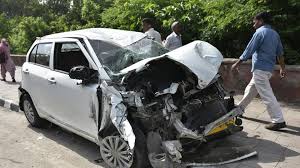
As I said earlier, my son was taking Drivers Ed. One of the other things he told me he learned was that 50% of all accidents involved some type of impairment. This number sounded high so I thought I would look into it. Here is what I found.
Every day, 29 people in the United States die in motor vehicle crashes that involve an alcohol-impaired driver.1 This is one death every 50 minutes.1 The annual cost of alcohol-related crashes totals more than $44 billion.2
Thankfully, there are effective measures that can help prevent injuries and deaths from alcohol-impaired driving.
- In 2016, 10,497 people died in alcohol-impaired driving crashes, accounting for 28% of all traffic-related deaths in the United States.1
- Of the 1,233 traffic deaths among children ages 0 to 14 years in 2016, 214 (17%) involved an alcohol-impaired driver.1
- In 2016, more than 1 million drivers were arrested for driving under the influence of alcohol or narcotics.3 That’s one percent of the 111 million self-reported episodes of alcohol-impaired driving among U.S. adults each year (figure below).
- Drugs other than alcohol (legal and illegal) are involved in about 16% of motor vehicle crashes.4
- https://www.cdc.gov/marijuana/what-we-know.html use is increasing and 13% of nighttime, weekend drivers have marijuana in their system.5
- Marijuana users were about 25% more likely to be involved in a crash than drivers with no evidence of marijuana use, however other factors–such as age and gender–may account for the increased crash risk among marijuana users.4
- Young people:
- At all levels of blood alcohol concentration (BAC), the risk of being involved in a crash is greater for young people than for older people.6
- Among drivers with BAC levels of 0.08% or higher involved in fatal crashes in 2016, nearly three in 10 were between 25 and 34 years of age (27%). The next two largest groups were ages 21 to 24 (26%) and 35 to 44 (22%).1
- Among motorcyclists killed in fatal crashes in 2016, 25% had BACs of 0.08% or greater.1
- Motorcyclists ages 35-39 have the highest percentage of deaths with BACs of 0.08% or greater (38% in 2016).7
- Drivers with a BAC of 0.08% or higher involved in fatal crashes were 4.5 times more likely to have a prior conviction for DWI than were drivers with no alcohol in their system. (9% and 2%, respectively).1
What are the effects of blood alcohol concentration (BAC)?
Information in this table shows the blood alcohol concentration (BAC) level at which the effect usually is first observed.Blood Alcohol Concentration (BAC)* Typical Effects Predictable Effects on Driving .02%
About 2 alcoholic drinks**- Some loss of judgment
- Relaxation
- Slight body warmth
- Altered mood
- Decline in visual functions (rapid tracking of a moving target)
- Decline in ability to perform two tasks at the same time (divided attention)
.05%
About 3 alcoholic drinks**- Exaggerated behavior
- May have loss of small-muscle control (e.g., focusing your eyes)
- Impaired judgment
- Usually good feeling
- Lowered alertness
- Release of inhibition
- Reduced coordination
- Reduced ability to track moving objects
- Difficulty steering
- Reduced response to emergency driving situations
.08%
About 4 alcoholic drinks**- Muscle coordination becomes poor (e.g., balance, speech, vision, reaction time, and hearing)
- Harder to detect danger
- Judgment, self-control, reasoning, and memory are impaired
- Concentration
- Short-term memory loss
- Speed control
- Reduced information processing capability (e.g., signal detection, visual search)
- Impaired perception
.10%
About 5 alcoholic drinks**- Clear deterioration of reaction time and control
- Slurred speech, poor coordination, and slowed thinking
- Reduced ability to maintain lane position and brake appropriately
.15%
About 7 alcoholic drinks**
How can deaths and injuries from impaired driving be prevented?
Effective measures include:- Actively enforcing existing 0.08% BAC laws, minimum legal drinking age laws, and zero tolerance laws for drivers younger than 21 years old in all states.4,8
- Requiring ignition interlocks for all offenders, including first-time offenders.9
- Using sobriety checkpoints.10
- Putting health promotion efforts into practice that influence economic, organizational, policy, and school/community action.11,12
- Using community-based approaches to alcohol control and DWI prevention.8,12,13
- Requiring mandatory substance abuse assessment and treatment, if needed, for DWI offenders.14
- Raising the unit price of alcohol by increasing taxes.15
What safety steps can individuals take?
Whenever your social plans involve alcohol and/or drugs, make plans so that you don’t have to drive while impaired. For example:- Before drinking, designate a non-drinking driver when with a group.
- Don’t let your friends drive impaired.
- If you have been drinking or using drugs, get a ride home, use a rideshare service or call a taxi.
- If you’re hosting a party where alcohol will be served, remind your guests to plan ahead and designate their sober driver; offer alcohol-free beverages, and make sure all guests leave with a sober driver.
- Far less muscle control than normal
- Vomiting may occur (unless this level is reached slowly or a person has developed a tolerance
for alcohol) - Major loss of balance
- Substantial impairment in vehicle control, attention to driving task, and in necessary visual and auditory information processing




